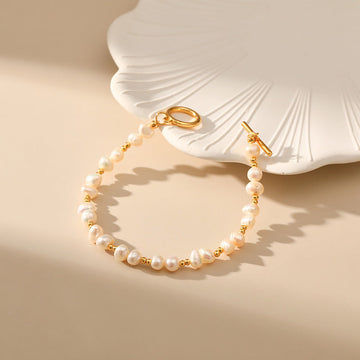Preventing and Managing Material Aging in Stone Bracelets
Stone bracelets, crafted from materials like jade, quartz, or gemstones, are cherished for their beauty and durability. However, prolonged exposure to environmental factors and daily wear can lead to material aging, such as discoloration, cracking, or loss of luster. This guide provides actionable strategies to prevent and address aging in stone bracelets, ensuring they remain vibrant and structurally sound.
Understanding the Causes of Material Aging
Environmental Stressors
Several external factors accelerate aging in stone bracelets:
- UV Exposure: Prolonged sunlight or artificial light exposure can fade colors and weaken the stone’s structure. For example, ultraviolet rays may oxidize iron-rich minerals in certain stones, causing red or brown discoloration.
- Humidity and Temperature Fluctuations: Extreme moisture or heat can cause stones to expand or contract, leading to cracks. Porous stones like turquoise are particularly vulnerable to water absorption, which may result in warping or discoloration.
- Chemical Exposure: Contact with cosmetics, perfumes, or cleaning agents can erode the stone’s surface or alter its chemical composition. Even mild acids in sweat can gradually damage sensitive stones.
Physical Wear and Tear
Daily use introduces mechanical stress:
- Abrasion: Friction against hard surfaces or other jewelry can scratch or dull the stone’s finish.
- Impact Damage: Accidental drops or collisions may cause hidden fractures or chipping, especially in brittle stones like opal or quartz.
Proactive Prevention Strategies
Optimal Storage Conditions
Proper storage minimizes exposure to aging triggers:
- Cool, Dry Environments: Store bracelets in a temperature-controlled area away from direct sunlight or heating vents.
- Individual Protection: Use soft pouches or lined jewelry boxes to prevent scratches and reduce air exposure, which can slow oxidation.
- Humidity Control: Place silica gel packets in storage containers to absorb excess moisture, particularly in humid climates.
Mindful Wear Practices
Reduce physical stress during daily use:
- Avoid Physical Activity: Remove bracelets before exercising, gardening, or household chores to prevent impact damage or chemical exposure.
- Limit Cosmetic Contact: Apply perfumes, lotions, and hairsprays before putting on jewelry to avoid residue buildup.
- Rotate Jewelry: Alternate between multiple bracelets to reduce wear on any single piece.
Regular Cleaning and Maintenance
Routine care preserves the stone’s appearance and integrity:
- Gentle Cleaning: Use a soft, damp cloth to wipe the stone and metal components. Avoid harsh chemicals or ultrasonic cleaners, which may damage delicate stones.
- Polishing: For stones that benefit from it, use a microfiber cloth to restore shine without abrasives.
- Professional Inspection: Visit a jeweler annually to check for loose settings, cracks, or other signs of wear.
Addressing Signs of Aging
Treating Discoloration
If a stone fades or develops stains:
- Professional Rejuvenation: Jewelers may use specialized treatments, such as heat or chemical baths, to restore color. However, these methods carry risks and should only be performed by experts.
- Accept Natural Changes: Some aging, like patina formation on certain stones, is part of their natural evolution and may enhance their character.
Repairing Cracks and Chips
For damaged stones:
- Stabilization Techniques: Jewelers can fill cracks with clear epoxy or stabilize loose stones with adhesive. These repairs are often invisible and extend the bracelet’s lifespan.
- Repolishing: Minor surface scratches can be buffed out by a professional, though excessive polishing may reduce the stone’s size.
Rehydrating Porous Stones
For stones prone to drying out:
- Occasional Soaking: Submerge porous stones like turquoise in distilled water for a few hours to restore moisture. Avoid over-soaking, as it can cause swelling.
- Oil Treatments: Apply a thin layer of natural oil (e.g., jojoba or mineral oil) to the stone’s surface to seal in moisture. Wipe off excess oil to prevent residue.
Long-Term Care for Specific Stone Types
Delicate Stones (e.g., Opal, Pearl)
- Avoid Extreme Temperatures: Opals can crack if exposed to sudden heat or cold. Pearls are sensitive to acids and should be wiped clean after each wear.
- Storage in Moist Environments: Store opals in a damp cloth or sealed container to prevent dehydration.
Hard Stones (e.g., Jade, Quartz)
- Prevent Impact Damage: Though durable, these stones can still chip or fracture. Avoid wearing them during high-risk activities.
- Regular Polishing: Use a soft cloth to maintain their luster, as they are less prone to chemical damage.
Final Recommendations
Preventing and managing material aging in stone bracelets requires a combination of proactive care, mindful wear, and timely professional intervention. By understanding the specific needs of your stone type and adopting these strategies, you can preserve its beauty and value for generations. Remember, each stone is unique, so tailor your approach to its properties and vulnerabilities. With consistent attention, your stone bracelet will remain a timeless accessory.







